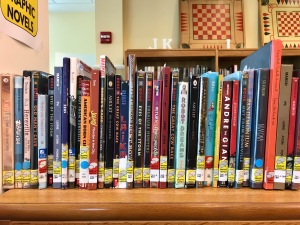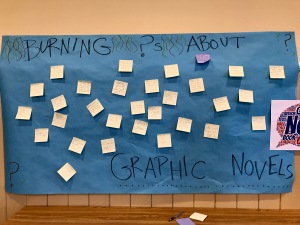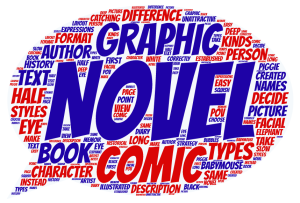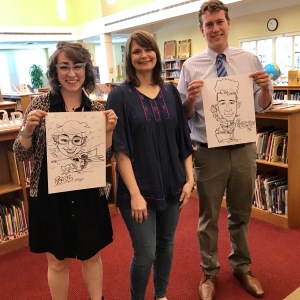It’s time for some real talk. I have to admit something. Something that most teachers and librarians will never admit. It’s not a particularly popular opinion amongst educators. But I’m not ashamed. I’ll shout it from the rooftops: I love graphic novels.

Seriously. I do. Give me all the epic adventure series, the cartoon fractured fairytales, the illustrated classics, even the angsty teen romances. The watercolors, the digital graphics, the pencil sketches. I love them all. They push and challenge me to read in a different way and to study and learn from illustrations and art like I never have before. They make scary subjects approachable and make funny moments even funnier. I can learn about a character from one frame’s body language or a facial expression what usually takes paragraphs to communicate. And they’re fun. Did I mention that they’re fun?
But here’s the thing – I’ve learned that fun and worthwhile don’t have to be mutually exclusive. Because they are colorful, and exciting, and don’t always take as long to read as traditional novels, doesn’t mean that they are any less worthy of readers’ time. Sometimes educators and parents, who so want the best for the children that they love, can miss out on that. And just like stories in poetry or prose, students don’t just naturally understand how to read graphic novels correctly. If you’ve ever seen a fourth grader whipping through a Raina Telgemeier book, it might be your first instinct to blame the book; but I think that it’s time to shift that mindset. Graphic novels aren’t a trend or a phase that’s going away any time soon, and that is reason to celebrate. And an excellent reason to start getting to know the format and figuring out how to use it to inspire and excite our students. It’s time that we started treating them like the serious and complex resource that they are…. and that means taking the time to teach students to read them correctly.
be your first instinct to blame the book; but I think that it’s time to shift that mindset. Graphic novels aren’t a trend or a phase that’s going away any time soon, and that is reason to celebrate. And an excellent reason to start getting to know the format and figuring out how to use it to inspire and excite our students. It’s time that we started treating them like the serious and complex resource that they are…. and that means taking the time to teach students to read them correctly.
Sixth grade English teacher Jared Passmore and I set a goal this year; not to guide students away from graphic novels to something more “serious”, but instead to help readers to see what graphic novels really are – worthwhile, serious, and profound pieces of literature. We were curious – could a shift of teacher mindset inspire a shift of student mindset? If we showed our appreciation and curiosity for the format and set the example of finding graphic novels worthwhile by dedicating valuable class time to them, would students start looking at them differently? And if we showed students how to find and appreciate the elements of literature in graphic novel format, would they slow down and start reading and discussing graphic novels like traditional novels?
Mr. Passmore and I spent an early spring afternoon planning and discussing, and created a graphic novel unit based on the following goals:
- increased middle school interest in reading
- increased middle school circulation and use of library materials and space
- better understanding of graphic novels
- increased respect for graphic novel format and artists
- understanding of and experience with locating and discussing elements of literature within graphic novels (providing greater mastery of skill by experiencing it in a new literary context)
- critical thinking in new literary context
- familiarity with major graphic novel styles, authors, and titles
Less scholarly but equally important goals included helping students to find their creative side, showing students respect and consideration by teaching the books that they have told us they love, learning more about this newly emerging story format ourselves, and creating lessons that were fun to teach and to learn.
 After planning, our next step was to clean out our local public libraries and read as many graphic novels as possible. We checked out about 35 graphic novels each, in addition to the graphic novels already available in the STAB library, to provide as large and diverse a sample for ourselves and our students as we could. For our first meeting introducing this new unit, we decided to begin by being honest. We let our students know – we’ve never taught this before. We don’t know much about graphic novels. But we know that we like them, and want to learn more. And we asked them ton consider – what do you want to learn about? Surrounded by post-it notes and pens, we gave them the full 50 minutes to read with reckless abandon. As they read, they wrote their questions on post-it notes and slapped them up on a Burning Questions display for us to use to guide our conversations. Check out the gallery below to see a few of their initial questions.
After planning, our next step was to clean out our local public libraries and read as many graphic novels as possible. We checked out about 35 graphic novels each, in addition to the graphic novels already available in the STAB library, to provide as large and diverse a sample for ourselves and our students as we could. For our first meeting introducing this new unit, we decided to begin by being honest. We let our students know – we’ve never taught this before. We don’t know much about graphic novels. But we know that we like them, and want to learn more. And we asked them ton consider – what do you want to learn about? Surrounded by post-it notes and pens, we gave them the full 50 minutes to read with reckless abandon. As they read, they wrote their questions on post-it notes and slapped them up on a Burning Questions display for us to use to guide our conversations. Check out the gallery below to see a few of their initial questions.
We then created a word cloud based on the common words in their questions so they could see which words and questions popped up the most, how we shaped our lessons around their questions, and where we would go next. One glance at the word cloud can show that our most common words included character, types, comic, text, styles, picture, decide, author, and format. These lined up with our goals of studying the elements of literature within this new format – so we were off to the races.
These lined up with our goals of studying the elements of literature within this new format – so we were off to the races.
Over the next few weeks, we tackled the elements of literature in a new and exciting way by experiencing them through the panels of our favorite graphic novels. To talk about setting, we compared frames from different artists that expressed setting in different ways, sharing what we could learn about the characters and the story from just that one snippet. For example: Setting. The woods in Raina Telgemeier’s Ghosts set a very different setting than those featured in Emily Carroll’s Through the Woods. Comparisons like these also helped us to talk about line style (round? angular?), size and prominence of frames (why is there only one imagine taking up this whole page, while this page has nine different frames on it? What is the author trying to tell us?), and color (why did this artist choose black and white? Would this story be different in color?). In each meeting, students had time to read and explore the topic in their books, and we met back at the end of class to discuss what they found and share examples. Not only this style of class help me to learn about different novels and perspectives, but it put students in the drivers seat and gave them even more ownership of the unit as we progressed. Our conversations were rich and interesting, and students that were normally slumped in the back row were suddenly animated. Something was happening – this was working.
In each meeting, students had time to read and explore the topic in their books, and we met back at the end of class to discuss what they found and share examples. Not only this style of class help me to learn about different novels and perspectives, but it put students in the drivers seat and gave them even more ownership of the unit as we progressed. Our conversations were rich and interesting, and students that were normally slumped in the back row were suddenly animated. Something was happening – this was working.
So we kept going. We kicked it up a notch and offered a graphic novel book club, exclusively for sixth grade students, during their lunch period. I tried to supress my victory dance as a first-time book club attendee and self proclaimed “not a reader” discussed the book with his peers while chewing on a pizza crust. During class, we read graphic novels along with our students, laughing and gasping and turning pages with as much eagerness as they did. And they noticed. They stopped trying to hide graphic novels under their desks or within the spines of other “more serious” texts. They started talking to us more openly about the books that they loved, the things that they questioned, and the lessons they learned. They started slowing down and taking in the setting, the facial expressions, the artistic style – and their comprehension of the text deepened. They were getting more from the stories than ever before. When we started treating graphic novels like a legitimate form of literature that was worth our time, they did, too.
 My favorite lesson centered on characterization. Rebecca Flowers, a librarian friend of mine and fellow Books on Bikes member, is an incredible artist and even moonlights as a caricaturist. She’s also very generous with her time – she agreed to come in to draw live and show students how artists use details in their drawings to give characters specific personality and character traits. Students made a list of 3-5 character traits for Mr. Passmore and me, and Ms. Flowers sketched us live, talking us through her artistic decisions as she went. For example, my words included adjectives like bubbly, excited, and sparkly, so Ms. Flowers gave me a face that opened upwards, wide eyes, and lots of motion in my body. Mr. Passmore’s adjectives were more serious, including wise, interesting, and kind, so he had a smaller smile and a more serious, closed face. Check out the video below to watch Ms. Flowers draw our characters and hear more about how artists create character personalities as they draw.
My favorite lesson centered on characterization. Rebecca Flowers, a librarian friend of mine and fellow Books on Bikes member, is an incredible artist and even moonlights as a caricaturist. She’s also very generous with her time – she agreed to come in to draw live and show students how artists use details in their drawings to give characters specific personality and character traits. Students made a list of 3-5 character traits for Mr. Passmore and me, and Ms. Flowers sketched us live, talking us through her artistic decisions as she went. For example, my words included adjectives like bubbly, excited, and sparkly, so Ms. Flowers gave me a face that opened upwards, wide eyes, and lots of motion in my body. Mr. Passmore’s adjectives were more serious, including wise, interesting, and kind, so he had a smaller smile and a more serious, closed face. Check out the video below to watch Ms. Flowers draw our characters and hear more about how artists create character personalities as they draw.
Last week, we announced that our graphic novel unit was coming to an end, and the groans and shouts of “NO!” were so loud, they nearly shook the windows. For our final activity, we wanted to give students an opportunity to take all that they had learned and put it to use in a fun, engaging, and lighthearted way. So we challenged them to think back on all of the elements of graphic novels that we had studied and use them to create a graphic novel featuring a very important character – themselves. We provided a planning sheet that prompted them to consider line style, color, shading, setting, background items, and character traits. They spent the class designing, drafting, coloring and shading. At the beginning of the unit, I’m confident that we would have had stick figures in capes – instead, we ended up with well thought-out and identifiable characters reflecting their personalities, hopes, and dreams in their illustrations. Check out the gallery below to see a small sample.
As we met to reflect on our unit and discuss possible improvements for next year, Mr. Passmore and I agreed that our time studying graphic novels exceeded our expectations. Our goals of increased student engagement, critical thinking, experience with the elements of literature in a different context, and increased appreciation and understanding of the format were met with flying colors. Students are reading graphic novels more slowly, carefully, and critically than ever before. Additionally, our time studying graphic novels brought unexpected benefits. Reluctant and struggling readers felt more relaxed and comfortable to be themselves in the library. Students shared their literary lives with us more openly, and with more excitement. In choosing to take their interests seriously, to “meet them where they are”, to use a famous educational term, we had validated and empowered them as readers. I’m not saying we changed the world here – but for awhile, our small slice of the world certainly felt a little different.
Teaching graphic novels in our English and reading classes strengthened our connections with our students. It showed them that the books that they love matter, and that we were willing to try something new to connect with them. It piqued their creativity, challenged them to think in new ways, and renewed their passion for their time in the library. And remember what I said about fun? That stands true. It was really, really fun.
Here’s the crux of the Great Graphic Novel Experiment: If you don’t like the way your students are flipping through their graphic novels or using them to avoid longer texts, then do something about it. And I don’t mean taking their copes of Big Nate or creating an enforced “Real Novels Only” reading time. Instead, get on board. Ask them for their favorite graphic novel titles, read them in plain view, and talk to your students about them. Teach them how to read graphic novels carefully and deeply, and help them to get the most out of these beautiful pieces of artwork. If you’re not a graphic novel expert, use some of the many resources online or contact an artist to get a professional point of view. Whatever you do, and however you do it, seize this unique opportunity! It’s not very often that a newly emerging, unbelievably engaging format falls into our laps. Instead of asking your students to put away their graphic novels in exchange for a “real” book, teach them how to treat graphic novels like the “real” books that they are – and to get the same joy, wisdom, and passion from their pages.
Want more details about our Great Graphic Novel Experiment? I love collaborating! I’m happy to share lesson plans, worksheets, and online resources. Reach out to me via email at fitzbetweentheshelves@gmail.com or on Facebook, and let’s get our graphic novel on.

I so enjoyed reading about your and Mr. Passmore’s lesson involving graphic novels! It’s wonderful teachers like both of you, that inspire. As it is teacher appreciation day, a very big thank you to you both(and to other teacher’s like you) for finding new ways to impart the joy of reading!
LikeLike
Thank you so much! We had a blast teaching it. Your comment made my day. It’s all about the joy of reading!
LikeLiked by 1 person
This is very inspirational! Thank you for sharing it–
LikeLike
Thank you! It was so much fun. I hope that sharing will help more teachers feel comfortable teaching graphic novels in their classrooms.
LikeLike